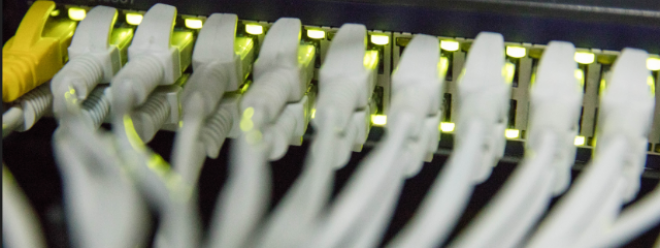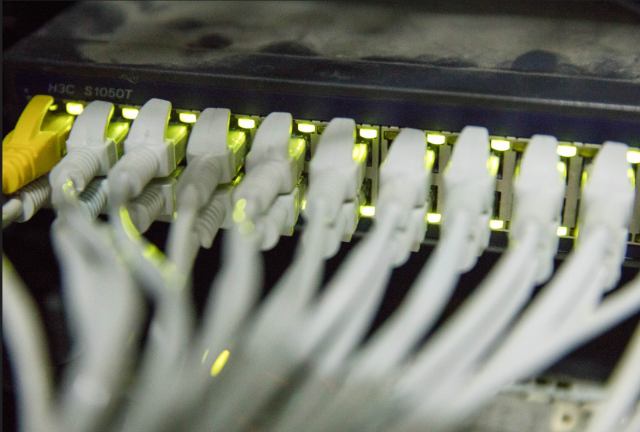What role does a switch play in a network?

What role does a switch play in a network?

Switches play an important role in increasing the speed of data transfer within a network. Efficiently directing data packets to their intended destination ensures that information is transmitted quickly and accurately.
How Switches Improve Data Transfer Speeds
Switches act like traffic cops, directing packets of data to their intended destination at lightning speed, making data transfers as fast as possible. When you send information over a network, it is broken down into smaller packets.
These packets travel across the network and are received by the switch. The switch then examines the destination address in each packet and determines where it needs to be sent.
By doing this quickly and efficiently, the switch ensures that each packet reaches its intended recipient without delay or bottlenecks.
One of the reasons a switch increases data transfer speed is that it creates a dedicated path for communication between devices.
Unlike a hub or repeater, which broadcasts data to all connected devices, a switch intelligently routes traffic only to the devices that need it. This removes unnecessary congestion on the network and allows for faster data transfers.
Additionally, switches have multiple ports that can handle simultaneous connections, enabling multiple devices to communicate at the same time without interference or slowdown.
With their ability to optimize data flow and provide direct connections between devices, switches are crucial in ensuring efficient and fast data transfer within a network.
The role of switches in data protection
One of the fundamental functions of a switch in a network is to secure data and protect sensitive information from unauthorized access. By creating separate collision domains, switches prevent unauthorized devices from intercepting or accessing data packets.
Each device connected to the switch has its own dedicated path to send and receive data, reducing the risk of data breaches and ensuring that only the intended recipients have access to information.
In addition, the switch utilizes MAC address filtering to enhance data security. They maintain tables of MAC addresses that map specific addresses to corresponding physical ports.
When a packet arrives at the switch, it checks the destination address and compares it to the entries in the table. If there is a match, the switch forwards the packet only to the port associated with that specific MAC address. This process prevents unauthorized devices from intercepting or accessing sensitive information because they are not included in the MAC address table.
Switches play a vital role in securing network data. Creating separate collision domains and utilizing MAC address filtering technology ensures that only authorized devices can access sensitive information while preventing unauthorized access or interception of data packets.
How Switches Optimize Network Traffic
To optimize network traffic, switches can be utilized to ensure that data flows efficiently and smoothly. A switch acts as a central hub for all devices connected to the network.
It receives data packets from a device and forwards the data packets to the corresponding destination device based on its MAC address. By doing this, the switch helps prevent unnecessary data congestion and collisions that can occur when multiple devices try to send data at the same time.
One way switches optimize network traffic is by creating separate collision domains for each port. In other words, each device connected to the switch has its own dedicated connection, enabling it to transmit and receive data without interference from other devices on the network.
This eliminates conflicts and improves overall network performance. Switches also have built-in memory buffers that temporarily store incoming packets before forwarding them. This buffering feature allows the switch to accommodate bursts of incoming traffic without any packet loss, ensuring smooth and efficient data flow throughout the network.
Using a switch is critical to optimizing network traffic. It ensures efficient data flow by preventing collisions, providing dedicated connections to each device, and using memory buffers to efficiently handle bursts of incoming traffic.
By implementing a switch in a network setup, performance and reliability can be significantly improved while ensuring seamless communication between devices on the network.
Explore the role of switches in network expansion
As we explore network scaling, we'll discover how switches are critical in enhancing connectivity and ensuring seamless communication between all devices. A switch acts as a central hub connecting multiple network devices.
It enables efficient data transfer by directing traffic only to intended receiving devices, eliminating unnecessary congestion and improving network performance. Switches facilitate network expansion in four ways:
Increased port capacity : As you expand your network, you may need to connect more devices than before. The switch provides multiple ports to which each device can be directly connected, enabling easy expansion without compromising performance.
Increased bandwidth: As the number of connected devices increases, so does the need for bandwidth. The switch enables multiple simultaneous high-speed connections, ensuring each device gets enough bandwidth to maintain peak performance.
Enhanced Security: As networks expand, so does the risk of unauthorized access or data breaches. Switches provide security features such as VLANs (Virtual Local Area Networks) and port authentication protocols to protect the network from threats.
Efficient Network Management : Managing large networks can only become complicated if you use the proper organizational tools. The switch provides management features such as quality of service (QoS), which can prioritize certain types of traffic to ensure that critical applications receive sufficient resources.
By understanding and leveraging these advantages of switches in your network expansion efforts, you can create a robust infrastructure that seamlessly handles growing connectivity demands while maintaining overall system efficiency and security.
Efficient Network Organization with Switches
By harnessing the power of switches, a network can be transformed into a well-organized and smooth-running system, ensuring that every device communicates seamlessly with each other.
Switches play a vital role in efficient network organization by creating multiple collision domains. This means that each port on the switch acts as a separate collision domain, preventing data collisions and enabling simultaneous communication between devices connected to different ports.
Utilizing switches in your network helps create an organized and optimized system that enables devices to communicate seamlessly. By segmenting the network, prioritizing traffic, and efficiently utilizing available bandwidth, switches enhance overall network performance and ensure smooth operation of all connected devices.
Summarize
What is the role of a switch in a network? We wanted to gain a clear understanding of the integral role switches play in network operations. Switches are the true unsung heroes of the networking world. They increase speed, protect against threats, optimize traffic, and scale easily.
Seamless communication and efficient data transfer between devices and networks would not be possible without switches, making them an essential building block in networks.